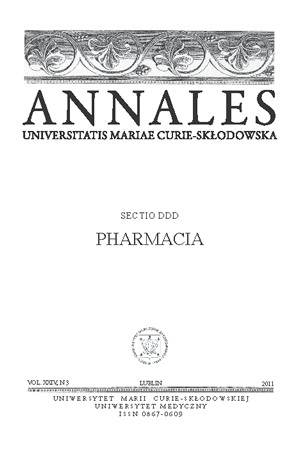Influence of nitrogen nutrition and cultivar on quality of sweet basil herbs
DOI:
https://doi.org/10.12923/Keywords:
Ocimum basilicum L., nitrogen, cultivar, macroelementsAbstract
Rational cultivation of herbs results in their higher quality and leads to unification of the material. Commercial sale of increasing number of pot plants for spices and medicinal products leads to the necessity of developing strict nutrition recommendations for such plants. The aim of the research was to define changes of volatile oil content and its qualitative composition, yield and biological value of Ocimum basilicum L. influenced by diversified nitric nutrition and cultivars. Experiment with Ocimum basilicum L. (cultivars with green and purple leaves and spherical habit) was conducted in a green house. Nutrients were used in the following amounts (per g·dm-3 of medium): N-0,6 (calcium nitrate, ammonium nitrate and urea); P-0,5 (superphosphate 20,2% P); K-1,0 (potassium sulphate); Mg-0,4 (magnesium sulphate monohydrate). The results of the experiment were very interesting. Yield of Ocimum basilicum L. did not significantly differ as the effect of applied nitrate fertilizer. Yet the cultivar had significant effect of the size of plant fresh weight. Average total yield equaled 228.7 g plant-1 . It should be emphasized that the experimental factors in use had significant influence on the concentration of volatile oil, nitrates and vitamin C in Ocimum basilicum L. The cultivar with spherical habit was characterized by the greatest content of volatile oil and the smallest amount of nitrates. Linalool concentration in the oil depended also on the type of nitrate fertilizer applied and on cultivar. The highest content of this compound was noted in Ocimum basilicum L. with green leaves fed with urea. Based on the acquired results, conclusion can be made that plant feeding and cultivar selection are those factors that affect the size and quality of material of Ocimum basilicum L.
References
1. Dzida K.: Nutrients contents in sweet basil (Ocimum basilicum L.) herb depending on calcium carbonate dose and cultivar. Acta Sci. Pol. Hortorum Cultus, 9(4), 143, 2010a.
2. Dzida K.: Biological value and Essentials oil content in sweet basil (Ocimum basilicum L.) herb depending on calcium carbonate dose and cultivar. Acta Sci. Pol. Hortorum Cultus 9(4), 153, 2010b.
3. Golcz A., Seidler-Łożykowska, Kozik E., Mieloszyk E.: Zawartość mikroskładników w surowcach wybranych gatunków roślin zielarskich z upraw ekologicznych. Rocz. AR Pozn. CCCLXXXIII, Ogrodn. 41, 477, 2007.
4. Golcz A., Politycka B, Seidler-Łożykowska K.: The effect of nitrogen fertilization and stage of plant development on the mass and quality of sweet basil leaves (Ocimum basilicum L.). Herba Polonica, 52, 1/2, 22, 2006.
5. Golcz A., Politycka B.: Nawożenie azotem a plon i zawartość barwników w liściach bazylii wonnej (Ocimum basilicum L.). Herba Polonica, 51, Supplement 1, 93, 2005.
6. Golcz A., Seidler-Łożykowska K., Markiewicz B.: Effect of increasing nitrogen doses and harvest terms on the growth and development of sweet Basil (Ocimum basilicum L.). Part I. Herba Polonica, XLVIII, 2, 55, 2002.
7. Grzeszczuk M., Jadczak D.: Estimation of biological value of some species of mint (Mentha L.). Herba Polonica, 55, 193, 2009.
8. Grzeszczuk M., Jadczak D.: Estimation of biological value and suitability for freezing of some species of spice herbs. J. Elementolo. 13 (2), 211, 2008.
9. Kozłowski J.A., Wielgosz T., Cis J., Nowak G., Dawid - Pać R., Kuczyński S., Aszkiewicz E., Woźniak L.: Zioła z apteki natury. PUBLICAT S.A., Poznań, 2007.
10. Marotti M., Piccaglia R., Giovanelli E.: Differences in Essential Oil Composition of Basil (Ocimum basilicum L.) Italian Cultivars related to Morphological Characteristics. J. Agric. Food Chem. 44, 3926, 1996.
11. Martyniak-Przybyszewska B., Wojciechowski T.: Plonowanie wybranych gatunków roślin przyprawowych w rejonie Olsztyna. Folia Univ. Agric. Stetin., Agricultura 239(95), 245, 2004.
12. Nowosielski O.: Zasady opracowywania zaleceń nawozowych w ogrodnictwie. PWRiL, Warszawa, 1988.
13. Nurzyńska-Wierdak R.: Evaluation of morphological and development al variability and Essentials oil composition of selected Basil cultivars. Herba Polonica, 53, 3, 255, 2007.
14. Nurzyńska - Wierdak R.: Analiza zawartości i składu chemicznego olejku dwóch form bazylii wonnej (Ocimum basilicum L.). Ann. Univ. Mariae Curie-Skłodowska Sect. EEE 9 suppl., 189, 2001.
15. Omer E.A., Elsayed A-G.A., El-Lathy A., Khattab M.E., Sabra A.S.: Effect of the nitrogen fertilizer forms and time of their application on the yield of herb and essential oil of Ocimum americanum L. Herba Polonica, 54, 1, 34, 2008.
16. Őzcan M.M., Akbulut M.: Estimation of minerals, nitrate and nitrite contents of medicinal and aromatic plants used as Spice, condiments and herbal tea. Food Chemistry 106, 852, 2007.
17. Őzcan M., Arslan D., Űnver A.: Effect of drying methods on the mineral content of basil (Ocimum basilicum L.). Journal of Food Engineering 69, 375, 2005.
18. Őzcan M.: Mineral contents of some plants used as condiments in Turkey. Food Chemistry 84, 437, 2004.
19. Seidler-Łożykowska K., Kozik E., Golcz A., Mieloszyk E.: Zawartość makroelementów i olejku eterycznego w surowcach wybranych gatunków roślin zielarskich z upraw ekologicznych. Journal of Research and Applications in Agricultural Engineering 51(2), 161, 2006.
20. Senderski M.E.: Prawie wszystko o ziołach. Podkowa Leśna, 2007.
21. Suchorska K., Osińska E.: Analiza morfologiczno-rozwojowa oraz chemiczna 11 form Ocimum sp. – bazylia. Mat. VIII Ogólnopolskiego Zjazdu naukowego „Hodowla Roślin Ogrodniczych u progu XXI wieku”. Lublin, 115, 1999.
22. Suchorska-Orłowska J., Jadczak D., Brzostowska-Żelechowska D.: Zawartość niektórych mikroskładników w wybranych gatunkach ziół. Folia Hortic.Supl. 2, 174, 2006.
23. Witoszyńska T., Jendryczko A.: Rośliny lecznicze naturalnym źródłem mikroelementów. Wiadomości Zielarskie 4, 8, 1994.
Downloads
Published
Issue
Section
License
Copyright (c) 2011 Authors

This work is licensed under a Creative Commons Attribution-NonCommercial-NoDerivatives 3.0 Unported License.


